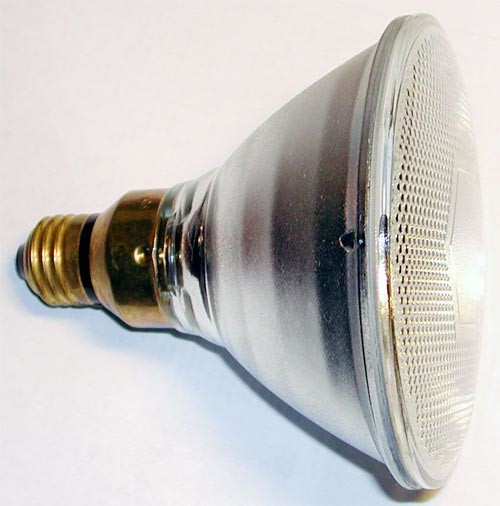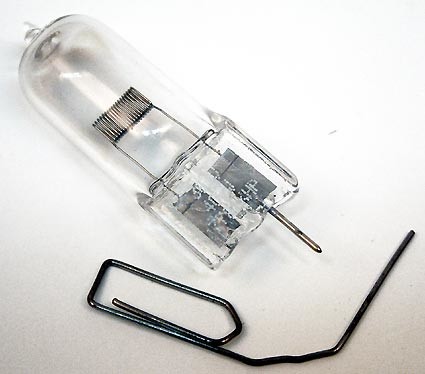 Halogen incandescent lampsThe fact is thatthe temperature of the filament cannot exceed a certain limit. Above this limit, the tungsten from which the filament is made begins to evaporate rapidly. The evaporating tungsten is deposited as a dark coating on the walls of the lamp, making it dimmer. The filament becomes thinner, causing the lamp to burn out quickly. In a halogen lamp, the evaporating metallic tungsten does not settle on the relatively cold walls of the bulb, but forms a volatile compound with the halogen. The tungsten halide circulates throughout the volume of the bulb, and, reaching the hot tungsten filament, decomposes into its original components. The halogen returns to the cycle, and the metallic tungsten partially settles on the filament, and partially remains in the form of an "atmosphere" around the filament. The increased concentration of tungsten vapors in the immediate vicinity of the filament sharply slows down its further evaporation, just as a humid atmosphere prevents wet laundry from drying. As a result, the filament does not become thinner, and the glass remains transparent. But this is not the only benefit of halogens. Now the filament can be heated even more, almost to the melting point of tungsten - because its evaporation is slowed down. This allows the color of their radiation to be brought closer to natural sunlight. The bright, beautiful, saturated light of halogen lamps is most successfully characterized by the epithet "juicy". Keep in mind that this "juiciness" does not run out throughout the entire service life of the lamps. And this service life is twice as long as a conventional incandescent lamp of similar power. The luminous efficiency of halogen lamps is twice as high as the luminous efficiency of conventional incandescent lamps. It follows that replacing conventional lamps with halogen ones will significantly reduce energy consumption. There are two types of halogen lamps: high-voltage, operating at 220 V, and low-voltage, at 6, 12, 24 and 36 V. 12-volt lamps are used more often. The advantages of low-voltage lamps are obvious - increased safety, especially in high humidity conditions, such as in the bathroom, and a longer service life. The average service life of 220-volt lamps is 2000 hours, 12-volt - 4000. However, they require a transformer that reduces the voltage from 220 to 12 V and separate wiring.
Halogen incandescent lampsThe fact is thatthe temperature of the filament cannot exceed a certain limit. Above this limit, the tungsten from which the filament is made begins to evaporate rapidly. The evaporating tungsten is deposited as a dark coating on the walls of the lamp, making it dimmer. The filament becomes thinner, causing the lamp to burn out quickly. In a halogen lamp, the evaporating metallic tungsten does not settle on the relatively cold walls of the bulb, but forms a volatile compound with the halogen. The tungsten halide circulates throughout the volume of the bulb, and, reaching the hot tungsten filament, decomposes into its original components. The halogen returns to the cycle, and the metallic tungsten partially settles on the filament, and partially remains in the form of an "atmosphere" around the filament. The increased concentration of tungsten vapors in the immediate vicinity of the filament sharply slows down its further evaporation, just as a humid atmosphere prevents wet laundry from drying. As a result, the filament does not become thinner, and the glass remains transparent. But this is not the only benefit of halogens. Now the filament can be heated even more, almost to the melting point of tungsten - because its evaporation is slowed down. This allows the color of their radiation to be brought closer to natural sunlight. The bright, beautiful, saturated light of halogen lamps is most successfully characterized by the epithet "juicy". Keep in mind that this "juiciness" does not run out throughout the entire service life of the lamps. And this service life is twice as long as a conventional incandescent lamp of similar power. The luminous efficiency of halogen lamps is twice as high as the luminous efficiency of conventional incandescent lamps. It follows that replacing conventional lamps with halogen ones will significantly reduce energy consumption. There are two types of halogen lamps: high-voltage, operating at 220 V, and low-voltage, at 6, 12, 24 and 36 V. 12-volt lamps are used more often. The advantages of low-voltage lamps are obvious - increased safety, especially in high humidity conditions, such as in the bathroom, and a longer service life. The average service life of 220-volt lamps is 2000 hours, 12-volt - 4000. However, they require a transformer that reduces the voltage from 220 to 12 V and separate wiring. The disadvantage of halogen lamps is theirincreased sensitivity to power surges, so it is advisable to switch them on through a voltage stabilizer. To achieve the greatest efficiency of the lamp, it is advisable to use it at full power, as stated by the manufacturer. However, its brightness can be adjusted using standard dimmers. By reducing the lamp power, you can reduce or even disable the halogen cycle, and it will start working like a regular incandescent lamp. To restore the halogens and remove metal particles of tungsten that have settled on the walls of the bulb, it is enough to turn on the lamp at full power for a few minutes. Among the disadvantages of halogen lamps, it should also be noted that the surface temperature of the bulb can reach 500? C, so you should strictly observe fire safety standards when installing lamps. You must not touch the lamp when it is on or when it has not cooled down enough, as this can lead to serious burns. And you should not touch the cooled lamp with bare hands. This leaves greasy stains on the lamp bulb, after switching on, the fat is charred under the influence of high temperature, the black particles of coal absorb heat and become very hot. Due to local overheating, the bulb may burst and the lamp may explode. The bulb should be handled using clean cloth gloves, a piece of clean cloth, or at least a paper napkin. If the bulb is dirty, it should be wiped with alcohol. Recently, low-voltage halogen lamps with a reflector have become widespread. In these lamps, up to two-thirds of the infrared radiation of the lamp is reflected by a translucent mirror, so the illuminated objects are less exposed to heating. Cooled lamps with a reflector can be handled with hands. The high color temperature of halogen lamps is not always a good thing - their spectrum contains excess ultraviolet radiation, which is harmful to health. Therefore, when buying a halogen lamp, pay special attention to whether it is equipped with ultraviolet protection.
The disadvantage of halogen lamps is theirincreased sensitivity to power surges, so it is advisable to switch them on through a voltage stabilizer. To achieve the greatest efficiency of the lamp, it is advisable to use it at full power, as stated by the manufacturer. However, its brightness can be adjusted using standard dimmers. By reducing the lamp power, you can reduce or even disable the halogen cycle, and it will start working like a regular incandescent lamp. To restore the halogens and remove metal particles of tungsten that have settled on the walls of the bulb, it is enough to turn on the lamp at full power for a few minutes. Among the disadvantages of halogen lamps, it should also be noted that the surface temperature of the bulb can reach 500? C, so you should strictly observe fire safety standards when installing lamps. You must not touch the lamp when it is on or when it has not cooled down enough, as this can lead to serious burns. And you should not touch the cooled lamp with bare hands. This leaves greasy stains on the lamp bulb, after switching on, the fat is charred under the influence of high temperature, the black particles of coal absorb heat and become very hot. Due to local overheating, the bulb may burst and the lamp may explode. The bulb should be handled using clean cloth gloves, a piece of clean cloth, or at least a paper napkin. If the bulb is dirty, it should be wiped with alcohol. Recently, low-voltage halogen lamps with a reflector have become widespread. In these lamps, up to two-thirds of the infrared radiation of the lamp is reflected by a translucent mirror, so the illuminated objects are less exposed to heating. Cooled lamps with a reflector can be handled with hands. The high color temperature of halogen lamps is not always a good thing - their spectrum contains excess ultraviolet radiation, which is harmful to health. Therefore, when buying a halogen lamp, pay special attention to whether it is equipped with ultraviolet protection.

Making Money with Desserts: Success Stories
Evgeniya Polischuk (Fedutinova) instagram:@evgeniyafedutinovavk.com/janeshomebaking– It all started with baking for family and friends. Gradually, I started posting photos of my baked goods on Instagram – and orders started coming in. I made my first custom-made cake on October 13, 2014, and a little earlier I started making macaroons and cupcakes. You could say that the business “found me”, I am very […]

Soups are cold recipes with photos
Cold cucumber soup with yogurt and lemonsorbet from the chef of the restaurant La Taverna Alexander Zhurkin Photo: Getty Images Ingredients: Plain yoghurt – 125 g Cucumber – 150 g Lemon/lime sorbet – 50 g Cocktail shrimp – 24 g Fresh ginger juice – 1 g Lime juice – 5 g Fresh orange juice – 5 g Parsley – 1 g Pink pepper – 1 g Watercress – […]

barbeque kebab
Pork tenderloin in glaze Photo:Dmitry Bayrak/dbstudioPreparation time: 20 minutes + marinating time.Calories: 454 kcal per serving.For 4 servings: 4 pork tenderloins (approximately 300 g each), 1 onion, 2 cloves of garlic, 1 tsp. lemon zest, 1 tsp. lemon juice, a pinch of ground cumin, coriander and turmeric, 1 tbsp. vegetable […]

Pierre Duacan: dietary recipes: Ducane diet
Beetroot soup Photo:Season’S, Luxury Hotels RepresentationYou will need:· Boiled beetroot – 60 g· Fresh cucumbers – 20 g· Red radish – 20 g· Green onions – 10 g· Egg – 1 pc.· Drinking mineral water – 200 g· Salt – 1 gPreparation:· Boil the egg and beetroot.· Grate the cucumbers, radish and part of the beetroot. Put everything […]





